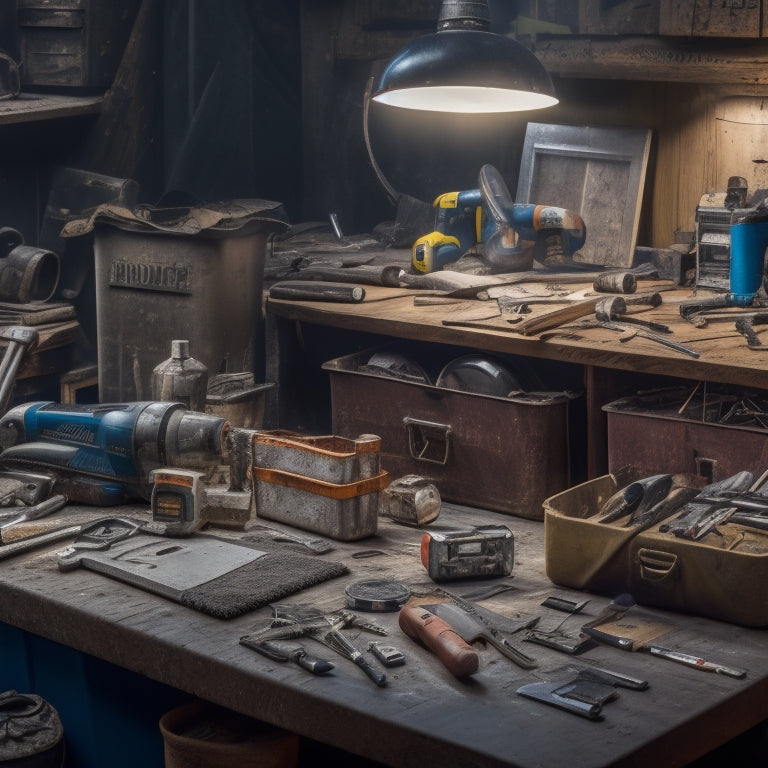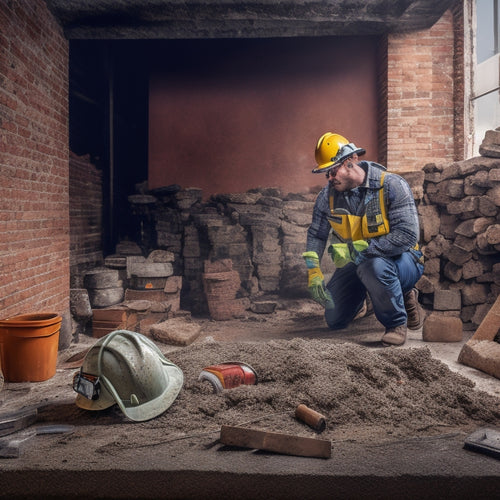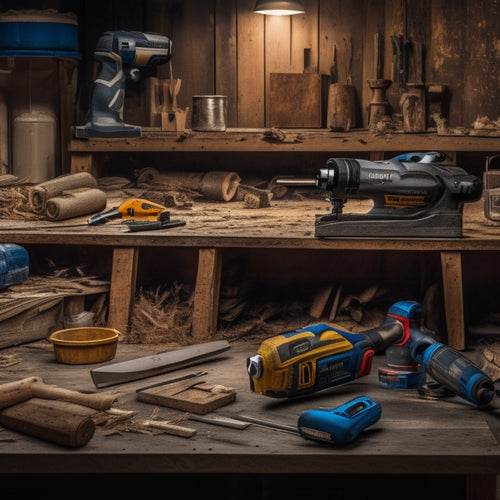
Smart Guide to Buying Second-Hand Renovation Tools
Share
When buying second-hand renovation tools, you'll want to set clear renovation goals and a realistic budget to prioritize your tool needs. Next, choose reliable online marketplaces that prioritize security and partner with trusted brands. Inspect tool condition carefully, checking for rust, worn parts, and testing functionality to guarantee performance and safety. Verify warranty and certification details, and research the seller's reputation thoroughly. By following these steps, you'll be well-equipped to navigate the process, and with a deeper understanding of what to look for, you'll make informed purchasing decisions that set your project up for success.
Key Takeaways
- Set clear renovation goals and a realistic budget to guide tool purchases and ensure project success.
- Inspect tools carefully for damage, wear, and functionality issues to avoid costly surprises.
- Research seller reputation, warranties, and certifications to ensure trustworthiness and tool reliability.
- Compare prices across multiple platforms, considering condition and seller reputation, to find the best deals.
- Factor in maintenance costs and develop a routine schedule to extend tool lifespan and prevent premature wear.
Set Clear Renovation Goals
Before diving into the world of second-hand renovation tools, define the scope of your project by setting clear renovation goals. Identify the specific areas of your project that require renovation, and prioritize them based on importance and urgency. This will help you determine the types of tools you need to purchase.
Next, establish a realistic budget for your project. Budget planning is vital to guarantee you don't overspend on tools and materials. Allocate funds for each aspect of the renovation, including tools, labor, and materials. Be prepared to adjust your budget as needed as the project progresses.
Create a project timeline to keep your renovation on track. Break down the project into manageable tasks and assign realistic deadlines to each one. This will help you stay focused and avoid procrastination.
A clear project timeline will also enable you to plan your tool purchases accordingly, making sure you have the right tools when you need them. By setting clear renovation goals, you'll be better equipped to navigate the world of second-hand renovation tools and achieve a successful outcome.
Choose Reliable Online Marketplaces
As you venture into the world of second-hand renovation tools, reliable online marketplaces become your go-to platforms for finding the right tools at affordable prices.
You'll want to focus on marketplaces that prioritize online security, ensuring your personal and financial information remains protected. Look for platforms that partner with trusted brands, as they typically have a vested interest in maintaining a positive reputation.
When evaluating online marketplaces, check for features like verified seller profiles, customer reviews, and clear return policies. These indicators can help you gauge the level of accountability and trustworthiness within the platform.
Additionally, opt for marketplaces that offer secure payment processing, such as PayPal or credit card transactions, which often provide an added layer of protection.
Inspect Tool Condition Carefully
When inspecting second-hand renovation tools, you'll want to scrutinize every aspect of the tool's condition.
Check for rust damage, which can weaken the tool's structure, and look for worn parts that may need replacement.
Be certain to test the tool's functionality as well, to guarantee it's working as intended.
Check for Rust Damage
Rust damage is a major red flag when inspecting second-hand renovation tools, and you'll want to scrutinize each tool's condition carefully to avoid buying a dud. A rusty tool can be a sign of poor maintenance, and it may not be reliable or safe to use. When inspecting tools, look for any signs of rust, such as flaking metal, reddish-brown discoloration, or corrosion.
| Tool Type | Rust Checkpoints | Rust Prevention Tips |
|---|---|---|
| Hand tools (e.g., wrenches, pliers) | Check for rust on metal surfaces, handles, and pivot points | Regularly clean and dry tools, apply rust-inhibiting coatings |
| Power tools (e.g., drills, saws) | Inspect metal casings, blades, and moving parts for rust | Store tools in dry areas, use rust-resistant materials |
| Fasteners (e.g., screws, nails) | Check for rust on threads, heads, and shafts | Use rust-resistant coatings, store fasteners in airtight containers |
| Measuring tools (e.g., levels, tapes) | Look for rust on metal components, such as hooks and blades | Clean and dry tools regularly, apply silicone-based lubricants |
| Storage cases | Check for rust on metal latches, hinges, and handles | Regularly clean and dry cases, apply rust-inhibiting coatings |
Look for Worn Parts
You'll want to inspect each tool's condition carefully to identify worn parts, which can considerably impact its performance and lifespan.
Check for signs of wear on moving components, such as loose or worn-out bearings, and inspect the tool's housing for cracks or dents. Worn-out seals or gaskets can lead to premature wear, so make sure to examine these closely.
Additionally, inspect the tool's electrical components, such as cords, switches, and plugs, for signs of wear or damage.
When inspecting worn parts, consider the tool's maintenance history and whether rust prevention measures were taken. If the tool has been properly maintained, worn parts may be minimal, and the tool's lifespan can be extended.
However, if neglect is evident, it may be wise to reconsider the purchase or factor in the cost of repairs. A thorough inspection will help you make an informed decision and avoid buying a tool that may require frequent repairs or replacement.
Test Tool Functionality
Inspecting the tool's condition is only half the battle; the real test of its worth lies in its functionality. When evaluating a second-hand renovation tool, you need to get hands-on and assess its performance. This is where you'll uncover any hidden issues that a visual inspection might've missed.
Start by powering up the tool and checking its motor or engine. Listen for any unusual noises, and observe its speed and efficiency. Perform a series of tasks that simulate real-world usage, such as drilling, sawing, or sanding. This will give you a sense of the tool's overall capability and user experience.
Take note of any vibrations, wobbles, or other issues that could affect its accuracy or safety. Your tool performance evaluation should also consider user experience feedback, such as how comfortable the grip is, how easy it's to maneuver, and how intuitive the controls are.
Check Warranty and Certifications
When purchasing second-hand renovation tools, verifying the warranty and certifications is essential to ascertain you're getting a reliable product. You don't want to end up with a tool that breaks down on the first use or poses a safety risk.
Warranty types vary, but common ones include:
| Warranty Type | Description | Duration |
|---|---|---|
| Manufacturer's Warranty | Covers defects in materials and workmanship | 1-5 years |
| Extended Warranty | Optional, provides additional coverage beyond standard warranty | 1-10 years |
| Refurbished Warranty | Covers previously used tools that have been restored to original condition | 3-12 months |
| No Warranty | No coverage provided, buyer assumes all risk | N/A |
Certification standards, such as UL (Underwriters Laboratories) or ETL (Intertek), ascertain the tool meets safety and performance standards. Look for the certification logo or documentation to confirm compliance. Don't take the seller's word for it – verify the warranty and certifications yourself to ascertain you're getting a reliable tool that meets your needs.
Research Seller Reputation Deeply
When buying second-hand renovation tools, you must research the seller's reputation thoroughly to avoid potential pitfalls.
Start by verifying the seller's identity and checking their online ratings to get a sense of their trustworthiness.
This process will help you identify red flags and guarantee you're dealing with a reputable seller.
Seller Verification Process
Frequently, buyers overlook the essential step of verifying a seller's reputation, only to regret it later. When buying second-hand renovation tools, it's vital to dig deeper into the seller's background to guarantee a smooth transaction.
Start by evaluating the seller's communication style. Are they responsive to your queries? Do they provide clear and concise answers? A reliable seller will maintain open and transparent communication throughout the process.
Next, investigate the seller's payment security measures. Do they use secure payment gateways or platforms that protect your financial information? Be cautious of sellers who insist on unconventional payment methods, as this could be a red flag for potential scams.
Additionally, clarify the return and refund policies in case you're not satisfied with the tools. A trustworthy seller will have a clear and fair return policy in place.
Check Online Ratings
During your research, you'll likely come across numerous online review platforms and marketplaces where sellers showcase their ratings. It's important to dig deeper and analyze these online reviews to get a thorough understanding of the seller's reputation.
-
Check the overall rating: A high rating doesn't always guarantee a smooth transaction. Look for consistency in the reviews and pay attention to red flags, such as repeated complaints about the same issue.
-
Read user feedback: Go beyond the star ratings and read the actual reviews. This will give you insight into the seller's communication style, packaging, and product quality.
-
Verify the number of reviews: A seller with a single 5-star review mightn't be as reliable as one with 50 reviews and a 4.5-star average.
- Look for patterns and trends: Identify patterns of negative feedback or common issues with the seller's products. This can indicate a larger problem that you'll want to avoid.
Compare Prices and Availability
Across various marketplaces and platforms, you'll encounter a wide range of prices for second-hand renovation tools, making it essential to compare prices and availability before making a purchase. This step helps you identify the best deals and avoid overpaying.
Keep in mind that prices can fluctuate rapidly due to market trends, so it's vital to stay informed.
To compare prices effectively, research multiple platforms, including online marketplaces, forums, and specialized websites. Make a list of the tools you need, and note their prices across different sources.
You may find that prices vary considerably depending on the seller, condition, and location. Be cautious of extremely low prices, as they may indicate a low-quality or defective tool.
Test Tools Before Purchase
Your toolbox is only as good as the tools it holds, so it's important to test second-hand renovation tools before sealing the deal. You don't want to end up with a tool that's faulty or inefficient, which can lead to project delays, poor quality work, and even safety risks.
When testing second-hand renovation tools, consider the following:
-
Check the tool's performance: Turn it on and see how it operates. Does it vibrate excessively? Does it produce the desired result? Are there any unusual noises or smells?
-
Inspect for signs of wear and tear: Look for rust, corrosion, or worn-out parts. Check the cords, plugs, and handles for damage or fraying.
-
Read user reviews and ratings: Research the tool online and see what other users have to say about its performance, durability, and reliability.
- Ask the seller about the tool's history: Find out how old the tool is, how it was used, and if it's been serviced or repaired.
Consider Tool Maintenance Costs
When you're purchasing second-hand renovation tools, it's vital to factor in the cost of maintenance to guarantee they continue to perform at their best throughout their lifespan. This includes considering the cost of replacement parts, lubricants, and any necessary repairs.
Regular maintenance is essential to extend tool longevity and prevent premature wear and tear. You should also factor in the time and effort required for maintenance, as this can impact your project timelines and budget.
To get the most out of your second-hand tools, develop a routine maintenance schedule that includes tasks such as cleaning, sharpening, and inspecting your tools regularly. Additionally, keep a record of maintenance activities to track performance and identify potential issues early on.
Negotiate Prices Confidently
Frequently, buyers of second-hand renovation tools overlook the importance of negotiating prices, often leaving money on the table. You don't have to be one of them.
To negotiate prices confidently, you need to be prepared and employ effective price negotiation tactics.
Here are some confidence building techniques to help you negotiate like a pro:
-
Know the market value: Research the tool's original price and its current market value to make a strong case for your desired price.
-
Identify flaws: Point out any defects or wear and tear to justify a lower price.
-
Set a target price: Decide on a maximum price you're willing to pay and stick to it.
- Be willing to walk away: If the seller is unwilling to meet your target price, be prepared to walk away from the deal.
Frequently Asked Questions
Can I Return a Used Tool if It Doesn't Fit My Needs?
When buying used tools, you should always review the seller's return policy before making a purchase, considering the tool's condition and ensuring it fits your needs, so you can return it if necessary.
How Do I Know if a Tool Is Stolen or Fraudulent?
You've got a million options staring you in the face, but don't get blinded by the deals - scrutinize the tool's provenance, looking for red flag indicators like suspiciously low prices, inconsistent serial numbers, or evasive sellers to avoid buying stolen or fraudulent tools.
Are Refurbished Tools as Reliable as New Ones?
You'll find that refurbished tools can be just as reliable as new ones, as they undergo rigorous quality assurance processes, and often come with warranty options, ensuring you're covered in case something goes wrong.
Can I Get a Discount if I Buy Multiple Tools at Once?
When making bulk purchases, you can leverage negotiation tactics to secure a discount. You'll likely get a better deal if you bundle tools from the same seller, so don't be afraid to ask about a package price.
Do I Need to Pay Taxes on Second-Hand Tool Purchases?
Think of buying second-hand tools like purchasing a used car - you're still driving on public roads, so you'll need to comply with local regulations. You'll likely need to pay sales tax on your second-hand tool purchases, so factor that into your budget.
Conclusion
You've got this! With these smart strategies, you'll be a second-hand renovation tool ninja, snagging high-quality deals and dodging costly mistakes. Think thousands of dollars saved, hours of frustration avoided, and a renovation that's nothing short of spectacular. You'll be the master of your DIY domain, with a toolbox that's both functional and affordable. Go forth, renovate wisely, and reap the rewards of your savvy shopping skills!
Related Posts
-

7 Must-Have Safety Gears for Brick Wall Renovation
When renovating a brick wall, you'll face a multitude of hazards, making it essential to wear and use the right safet...
-

10 Best Power Tools to Buy for Home Renovation
To tackle your home renovation project efficiently, you'll need the right power tools for the job. A cordless drill f...
-

Streamline Your Exterior Renovation Timeline
To streamline your exterior renovation timeline, you'll need to approach the process strategically. Start by planning...


